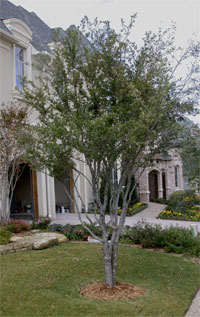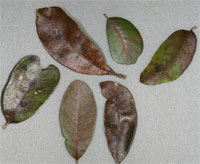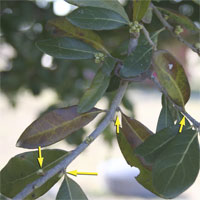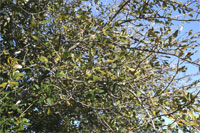Download PDF (PLPA-111)
Live oaks, also known as evergreen oaks, are beautiful and stately trees in the landscape. However, live oaks are NOT true evergreens. They do drop their old leaves as new leaves emerge in the spring. This is NORMAL and NOT a disease problem.
These trees may appear sickly when temperatures begin to rise a little, typically in late January and in February. Symptoms that are observed typically include yellowing. In many cases, the leaves may have spots or blotches that are brown or black. Quite often, they discolor in a relatively short time. These leaves are
senescing (aka dying off). The spots may be due to secondary infections by pathogens. Sometimes, these leaves may even have veins that turn brown while interveinal areas remain green. This particular symptom might be confused with a disease called “oak wilt”. Although the oak wilt fungus may attack the tree in the late winter and early spring, oak wilt symptoms are most often observed in the summer.
So what do I look for to determine if my tree is experiencing NORMAL leaf drop?
Look closely at the senescing (dying leaves) leaves, particularly for new buds that are found at the base of the leaf petiole. This bud may be very small early on, but they become more prominent as the older leaves begin to die. Shortly after the old leaf drops, you should see new tiny leaves from those new buds. If these buds are present, your tree is most likely experiencing its normal yearly leaf cycle.
If you do not see any buds, check to see if the branches are brittle (snaps when you bend it) and are brown on the inside instead of greenish-white. That branch is most likely dead. In a normal tree, there will usually be some dead branches. However, you may have a problem if you find more that 10% of the branches on your tree are dead. In this case, it is recommended that you talk to a certified arborist or contact your local county Extension office for assistance.
Prepared by Dr. Kevin Ong
Assistant Professor and Extension Urban Plant Pathologist
Texas AgriLife Extension Service; The Texas A&M University System
March 24, 2008
The information given herein is for educational purposes only. References to commercial products or trade names are made with the understanding that no discrimination is intended and no endorsement by Texas AgriLife Extension Service personnel is implied.
Educational programs of the Texas AgriLife Extension Service are open to all people without regard to race, color, sex, disability, religion, age, or national origin.
The Texas A&M University System, U.S. Department of Agriculture, and the County Commissioners Courts of Texas Cooperating



